The Royal Standard of England: Law and Licensing Report Analysis
VerifiedAdded on 2020/06/04
|15
|4250
|33
Report
AI Summary
This report provides a comprehensive analysis of law and licensing regulations relevant to licensed premises, using The Royal Standard of England as a case study. It explores different types of licenses, including personal and premises licenses, outlining the application procedures and differences between them. The report also details guidelines for staff conduct, emphasizing the importance of training and awareness of relevant laws. Furthermore, it includes a risk assessment plan for licensed premises, focusing on crime prevention measures. The report further examines consumer protection, addressing the consequences of providing misleading information and the extent of employer liability. Finally, it proposes and justifies a policy to ensure compliance with weight and measures legislation, suggesting specific changes to comply with the law.
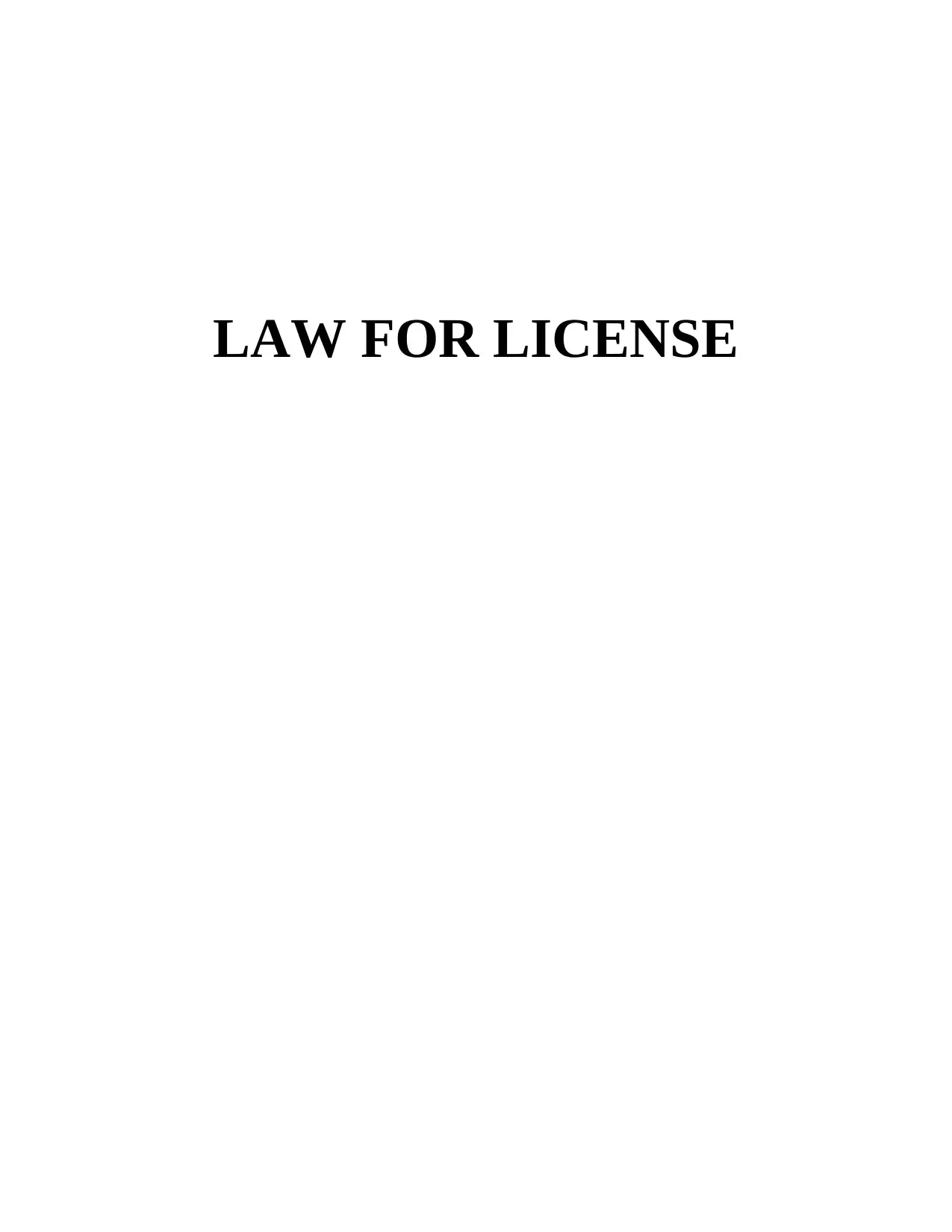
LAW FOR LICENSE
Paraphrase This Document
Need a fresh take? Get an instant paraphrase of this document with our AI Paraphraser
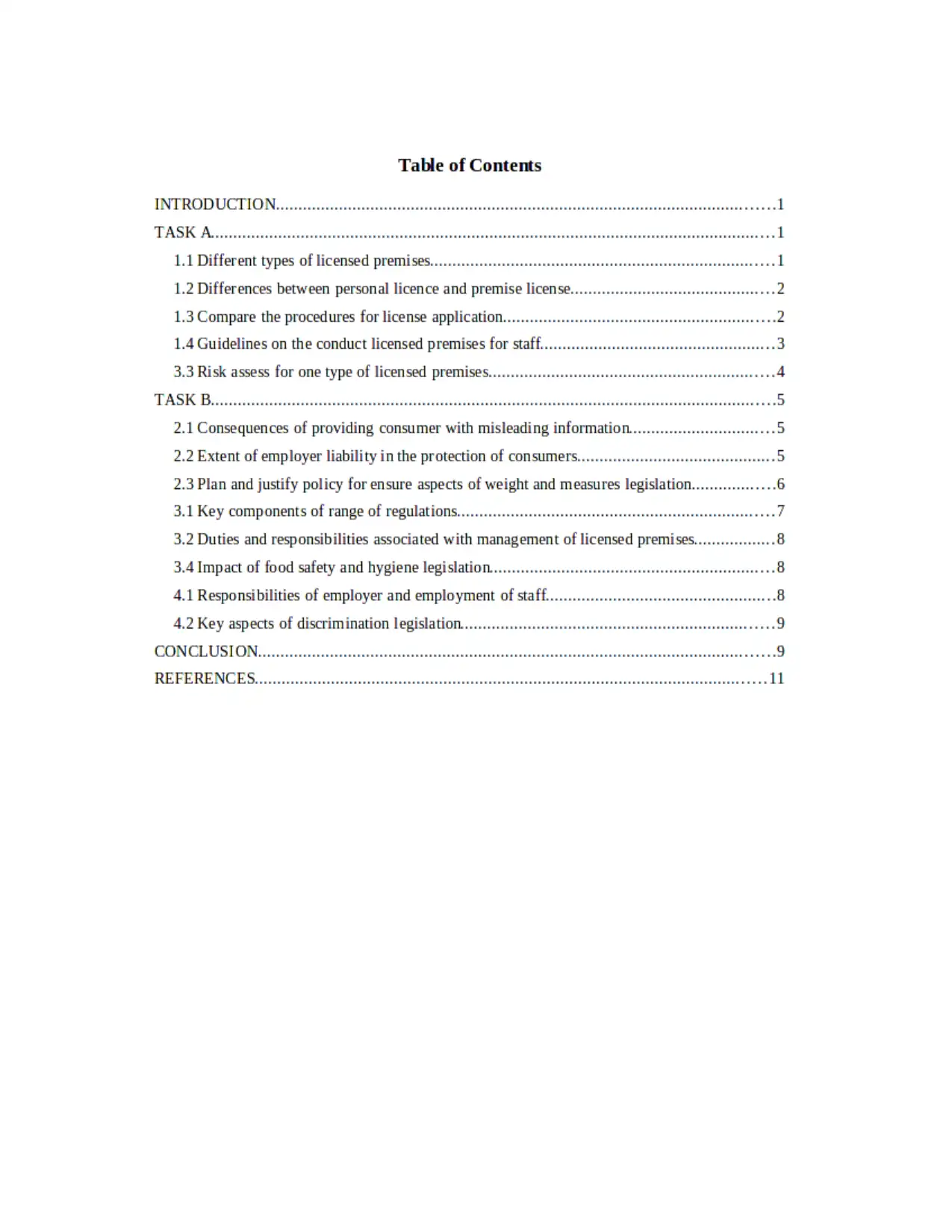

You're viewing a preview
Unlock full access by subscribing today!
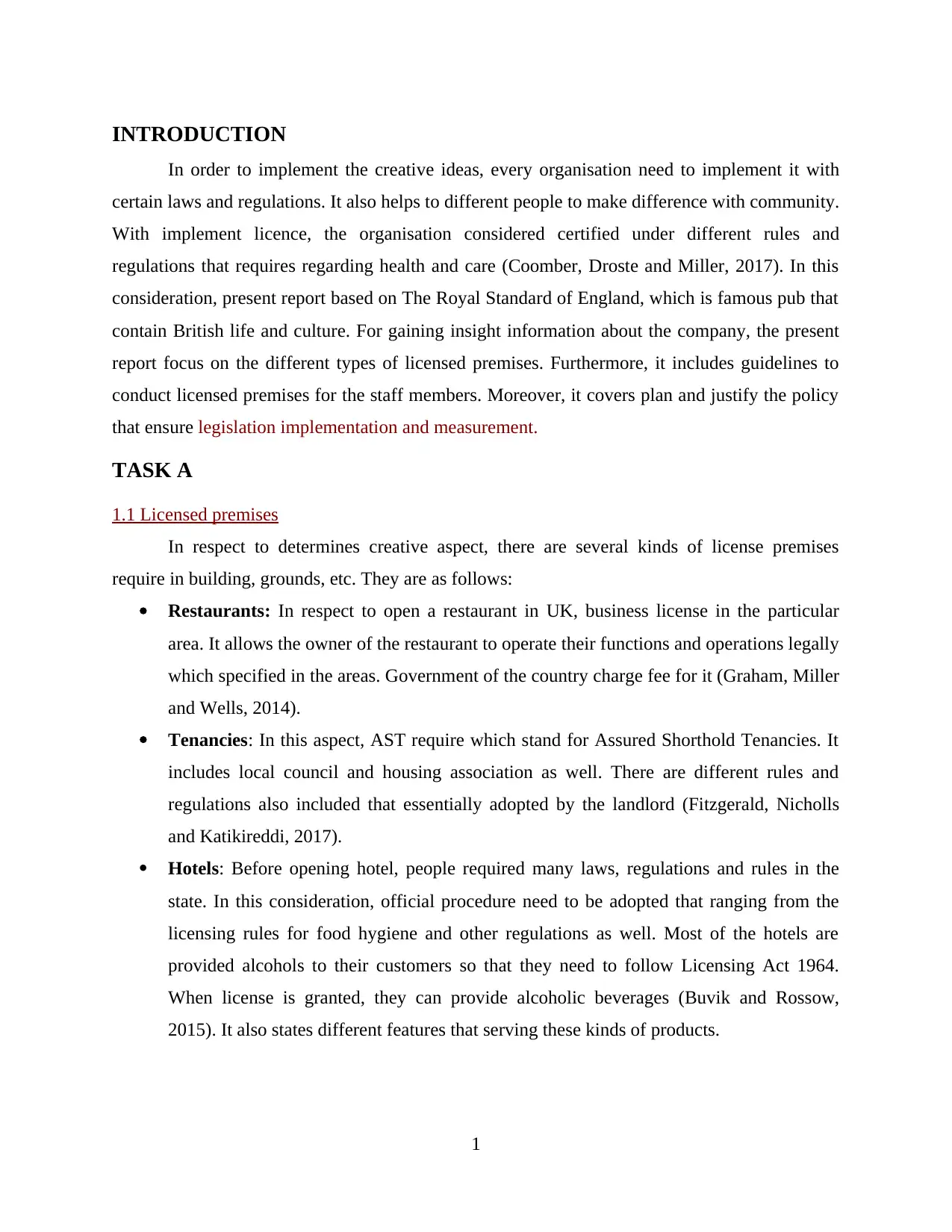
INTRODUCTION
In order to implement the creative ideas, every organisation need to implement it with
certain laws and regulations. It also helps to different people to make difference with community.
With implement licence, the organisation considered certified under different rules and
regulations that requires regarding health and care (Coomber, Droste and Miller, 2017). In this
consideration, present report based on The Royal Standard of England, which is famous pub that
contain British life and culture. For gaining insight information about the company, the present
report focus on the different types of licensed premises. Furthermore, it includes guidelines to
conduct licensed premises for the staff members. Moreover, it covers plan and justify the policy
that ensure legislation implementation and measurement.
TASK A
1.1 Licensed premises
In respect to determines creative aspect, there are several kinds of license premises
require in building, grounds, etc. They are as follows:
Restaurants: In respect to open a restaurant in UK, business license in the particular
area. It allows the owner of the restaurant to operate their functions and operations legally
which specified in the areas. Government of the country charge fee for it (Graham, Miller
and Wells, 2014).
Tenancies: In this aspect, AST require which stand for Assured Shorthold Tenancies. It
includes local council and housing association as well. There are different rules and
regulations also included that essentially adopted by the landlord (Fitzgerald, Nicholls
and Katikireddi, 2017).
Hotels: Before opening hotel, people required many laws, regulations and rules in the
state. In this consideration, official procedure need to be adopted that ranging from the
licensing rules for food hygiene and other regulations as well. Most of the hotels are
provided alcohols to their customers so that they need to follow Licensing Act 1964.
When license is granted, they can provide alcoholic beverages (Buvik and Rossow,
2015). It also states different features that serving these kinds of products.
1
In order to implement the creative ideas, every organisation need to implement it with
certain laws and regulations. It also helps to different people to make difference with community.
With implement licence, the organisation considered certified under different rules and
regulations that requires regarding health and care (Coomber, Droste and Miller, 2017). In this
consideration, present report based on The Royal Standard of England, which is famous pub that
contain British life and culture. For gaining insight information about the company, the present
report focus on the different types of licensed premises. Furthermore, it includes guidelines to
conduct licensed premises for the staff members. Moreover, it covers plan and justify the policy
that ensure legislation implementation and measurement.
TASK A
1.1 Licensed premises
In respect to determines creative aspect, there are several kinds of license premises
require in building, grounds, etc. They are as follows:
Restaurants: In respect to open a restaurant in UK, business license in the particular
area. It allows the owner of the restaurant to operate their functions and operations legally
which specified in the areas. Government of the country charge fee for it (Graham, Miller
and Wells, 2014).
Tenancies: In this aspect, AST require which stand for Assured Shorthold Tenancies. It
includes local council and housing association as well. There are different rules and
regulations also included that essentially adopted by the landlord (Fitzgerald, Nicholls
and Katikireddi, 2017).
Hotels: Before opening hotel, people required many laws, regulations and rules in the
state. In this consideration, official procedure need to be adopted that ranging from the
licensing rules for food hygiene and other regulations as well. Most of the hotels are
provided alcohols to their customers so that they need to follow Licensing Act 1964.
When license is granted, they can provide alcoholic beverages (Buvik and Rossow,
2015). It also states different features that serving these kinds of products.
1
Paraphrase This Document
Need a fresh take? Get an instant paraphrase of this document with our AI Paraphraser
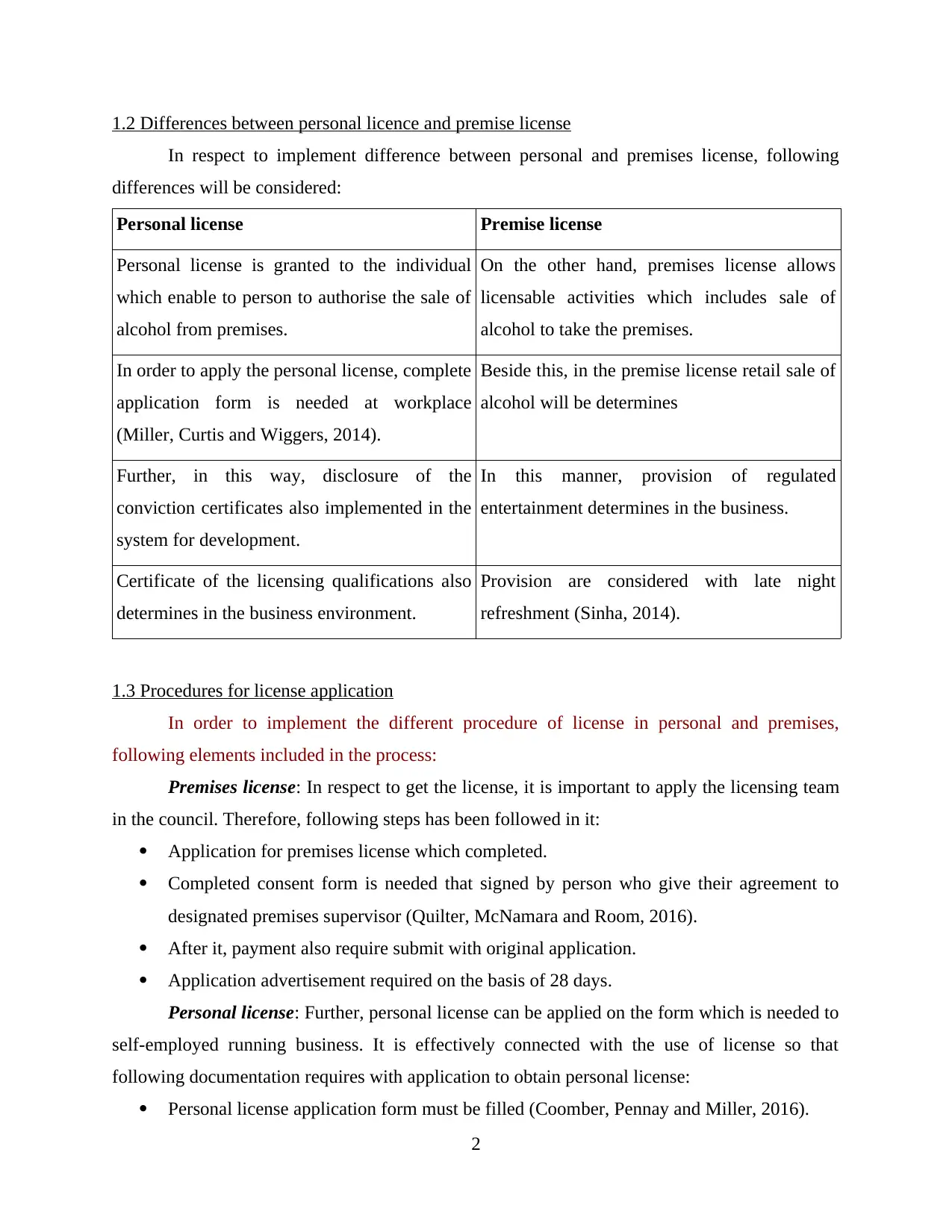
1.2 Differences between personal licence and premise license
In respect to implement difference between personal and premises license, following
differences will be considered:
Personal license Premise license
Personal license is granted to the individual
which enable to person to authorise the sale of
alcohol from premises.
On the other hand, premises license allows
licensable activities which includes sale of
alcohol to take the premises.
In order to apply the personal license, complete
application form is needed at workplace
(Miller, Curtis and Wiggers, 2014).
Beside this, in the premise license retail sale of
alcohol will be determines
Further, in this way, disclosure of the
conviction certificates also implemented in the
system for development.
In this manner, provision of regulated
entertainment determines in the business.
Certificate of the licensing qualifications also
determines in the business environment.
Provision are considered with late night
refreshment (Sinha, 2014).
1.3 Procedures for license application
In order to implement the different procedure of license in personal and premises,
following elements included in the process:
Premises license: In respect to get the license, it is important to apply the licensing team
in the council. Therefore, following steps has been followed in it:
Application for premises license which completed.
Completed consent form is needed that signed by person who give their agreement to
designated premises supervisor (Quilter, McNamara and Room, 2016).
After it, payment also require submit with original application.
Application advertisement required on the basis of 28 days.
Personal license: Further, personal license can be applied on the form which is needed to
self-employed running business. It is effectively connected with the use of license so that
following documentation requires with application to obtain personal license:
Personal license application form must be filled (Coomber, Pennay and Miller, 2016).
2
In respect to implement difference between personal and premises license, following
differences will be considered:
Personal license Premise license
Personal license is granted to the individual
which enable to person to authorise the sale of
alcohol from premises.
On the other hand, premises license allows
licensable activities which includes sale of
alcohol to take the premises.
In order to apply the personal license, complete
application form is needed at workplace
(Miller, Curtis and Wiggers, 2014).
Beside this, in the premise license retail sale of
alcohol will be determines
Further, in this way, disclosure of the
conviction certificates also implemented in the
system for development.
In this manner, provision of regulated
entertainment determines in the business.
Certificate of the licensing qualifications also
determines in the business environment.
Provision are considered with late night
refreshment (Sinha, 2014).
1.3 Procedures for license application
In order to implement the different procedure of license in personal and premises,
following elements included in the process:
Premises license: In respect to get the license, it is important to apply the licensing team
in the council. Therefore, following steps has been followed in it:
Application for premises license which completed.
Completed consent form is needed that signed by person who give their agreement to
designated premises supervisor (Quilter, McNamara and Room, 2016).
After it, payment also require submit with original application.
Application advertisement required on the basis of 28 days.
Personal license: Further, personal license can be applied on the form which is needed to
self-employed running business. It is effectively connected with the use of license so that
following documentation requires with application to obtain personal license:
Personal license application form must be filled (Coomber, Pennay and Miller, 2016).
2
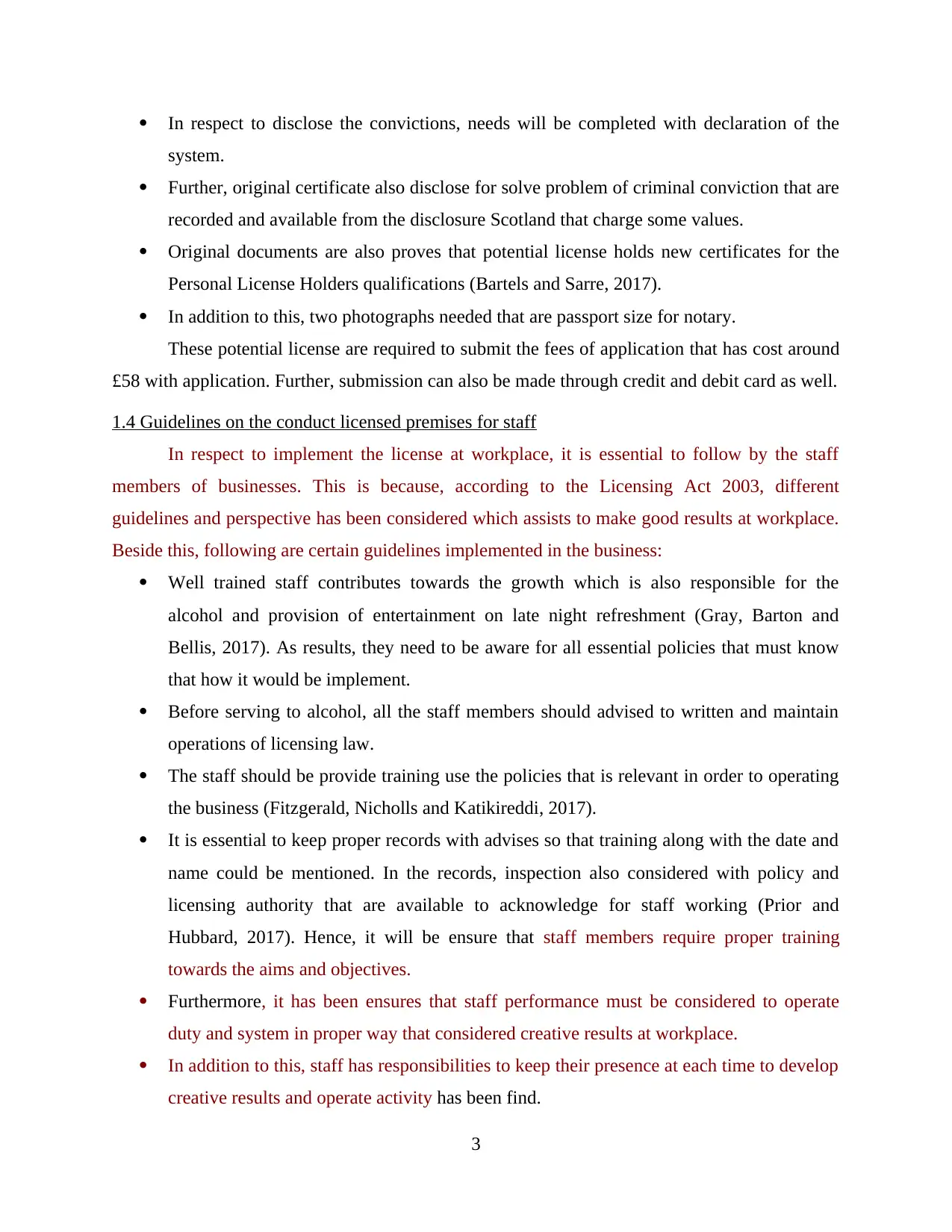
In respect to disclose the convictions, needs will be completed with declaration of the
system.
Further, original certificate also disclose for solve problem of criminal conviction that are
recorded and available from the disclosure Scotland that charge some values.
Original documents are also proves that potential license holds new certificates for the
Personal License Holders qualifications (Bartels and Sarre, 2017).
In addition to this, two photographs needed that are passport size for notary.
These potential license are required to submit the fees of application that has cost around
£58 with application. Further, submission can also be made through credit and debit card as well.
1.4 Guidelines on the conduct licensed premises for staff
In respect to implement the license at workplace, it is essential to follow by the staff
members of businesses. This is because, according to the Licensing Act 2003, different
guidelines and perspective has been considered which assists to make good results at workplace.
Beside this, following are certain guidelines implemented in the business:
Well trained staff contributes towards the growth which is also responsible for the
alcohol and provision of entertainment on late night refreshment (Gray, Barton and
Bellis, 2017). As results, they need to be aware for all essential policies that must know
that how it would be implement.
Before serving to alcohol, all the staff members should advised to written and maintain
operations of licensing law.
The staff should be provide training use the policies that is relevant in order to operating
the business (Fitzgerald, Nicholls and Katikireddi, 2017).
It is essential to keep proper records with advises so that training along with the date and
name could be mentioned. In the records, inspection also considered with policy and
licensing authority that are available to acknowledge for staff working (Prior and
Hubbard, 2017). Hence, it will be ensure that staff members require proper training
towards the aims and objectives.
Furthermore, it has been ensures that staff performance must be considered to operate
duty and system in proper way that considered creative results at workplace.
In addition to this, staff has responsibilities to keep their presence at each time to develop
creative results and operate activity has been find.
3
system.
Further, original certificate also disclose for solve problem of criminal conviction that are
recorded and available from the disclosure Scotland that charge some values.
Original documents are also proves that potential license holds new certificates for the
Personal License Holders qualifications (Bartels and Sarre, 2017).
In addition to this, two photographs needed that are passport size for notary.
These potential license are required to submit the fees of application that has cost around
£58 with application. Further, submission can also be made through credit and debit card as well.
1.4 Guidelines on the conduct licensed premises for staff
In respect to implement the license at workplace, it is essential to follow by the staff
members of businesses. This is because, according to the Licensing Act 2003, different
guidelines and perspective has been considered which assists to make good results at workplace.
Beside this, following are certain guidelines implemented in the business:
Well trained staff contributes towards the growth which is also responsible for the
alcohol and provision of entertainment on late night refreshment (Gray, Barton and
Bellis, 2017). As results, they need to be aware for all essential policies that must know
that how it would be implement.
Before serving to alcohol, all the staff members should advised to written and maintain
operations of licensing law.
The staff should be provide training use the policies that is relevant in order to operating
the business (Fitzgerald, Nicholls and Katikireddi, 2017).
It is essential to keep proper records with advises so that training along with the date and
name could be mentioned. In the records, inspection also considered with policy and
licensing authority that are available to acknowledge for staff working (Prior and
Hubbard, 2017). Hence, it will be ensure that staff members require proper training
towards the aims and objectives.
Furthermore, it has been ensures that staff performance must be considered to operate
duty and system in proper way that considered creative results at workplace.
In addition to this, staff has responsibilities to keep their presence at each time to develop
creative results and operate activity has been find.
3
You're viewing a preview
Unlock full access by subscribing today!
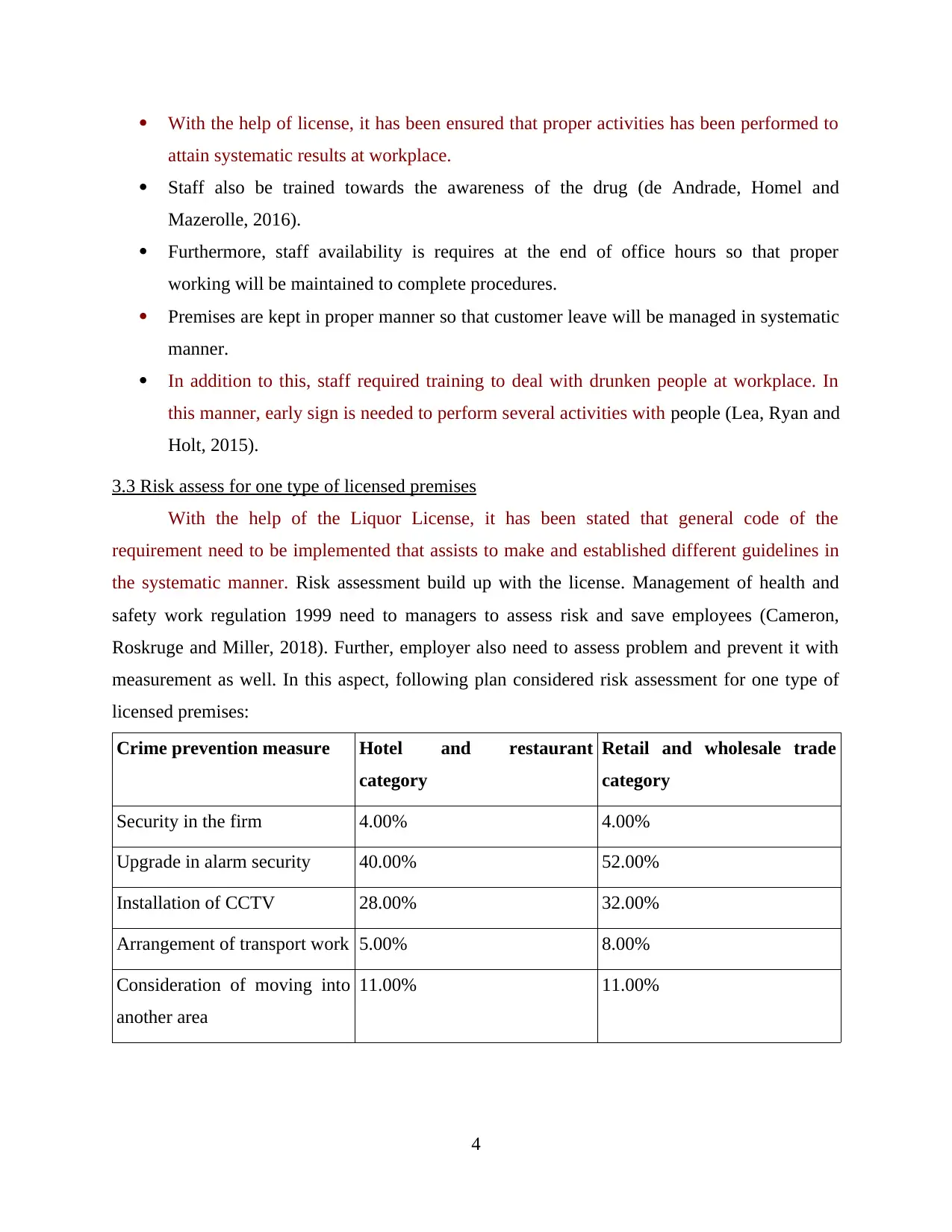
With the help of license, it has been ensured that proper activities has been performed to
attain systematic results at workplace.
Staff also be trained towards the awareness of the drug (de Andrade, Homel and
Mazerolle, 2016).
Furthermore, staff availability is requires at the end of office hours so that proper
working will be maintained to complete procedures.
Premises are kept in proper manner so that customer leave will be managed in systematic
manner.
In addition to this, staff required training to deal with drunken people at workplace. In
this manner, early sign is needed to perform several activities with people (Lea, Ryan and
Holt, 2015).
3.3 Risk assess for one type of licensed premises
With the help of the Liquor License, it has been stated that general code of the
requirement need to be implemented that assists to make and established different guidelines in
the systematic manner. Risk assessment build up with the license. Management of health and
safety work regulation 1999 need to managers to assess risk and save employees (Cameron,
Roskruge and Miller, 2018). Further, employer also need to assess problem and prevent it with
measurement as well. In this aspect, following plan considered risk assessment for one type of
licensed premises:
Crime prevention measure Hotel and restaurant
category
Retail and wholesale trade
category
Security in the firm 4.00% 4.00%
Upgrade in alarm security 40.00% 52.00%
Installation of CCTV 28.00% 32.00%
Arrangement of transport work 5.00% 8.00%
Consideration of moving into
another area
11.00% 11.00%
4
attain systematic results at workplace.
Staff also be trained towards the awareness of the drug (de Andrade, Homel and
Mazerolle, 2016).
Furthermore, staff availability is requires at the end of office hours so that proper
working will be maintained to complete procedures.
Premises are kept in proper manner so that customer leave will be managed in systematic
manner.
In addition to this, staff required training to deal with drunken people at workplace. In
this manner, early sign is needed to perform several activities with people (Lea, Ryan and
Holt, 2015).
3.3 Risk assess for one type of licensed premises
With the help of the Liquor License, it has been stated that general code of the
requirement need to be implemented that assists to make and established different guidelines in
the systematic manner. Risk assessment build up with the license. Management of health and
safety work regulation 1999 need to managers to assess risk and save employees (Cameron,
Roskruge and Miller, 2018). Further, employer also need to assess problem and prevent it with
measurement as well. In this aspect, following plan considered risk assessment for one type of
licensed premises:
Crime prevention measure Hotel and restaurant
category
Retail and wholesale trade
category
Security in the firm 4.00% 4.00%
Upgrade in alarm security 40.00% 52.00%
Installation of CCTV 28.00% 32.00%
Arrangement of transport work 5.00% 8.00%
Consideration of moving into
another area
11.00% 11.00%
4
Paraphrase This Document
Need a fresh take? Get an instant paraphrase of this document with our AI Paraphraser
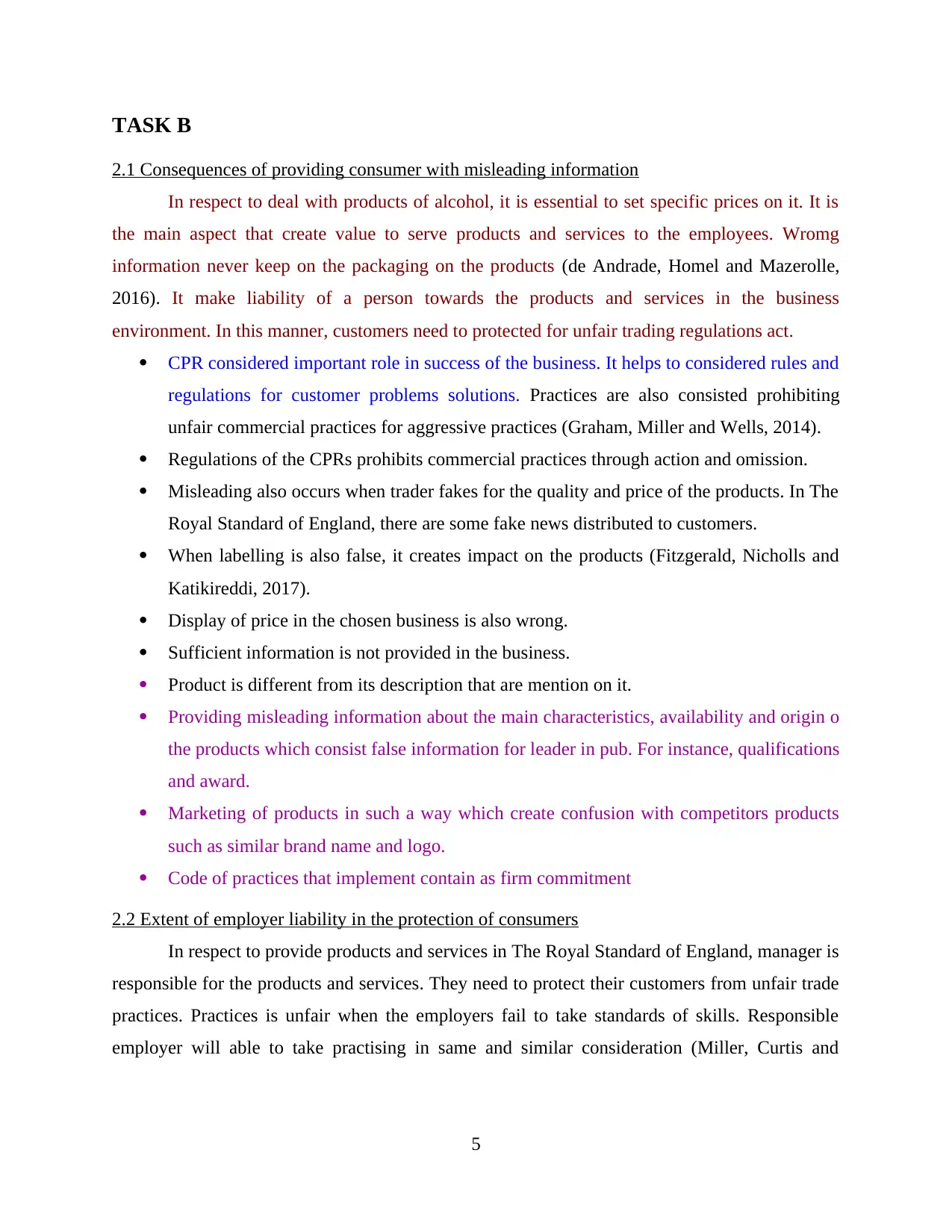
TASK B
2.1 Consequences of providing consumer with misleading information
In respect to deal with products of alcohol, it is essential to set specific prices on it. It is
the main aspect that create value to serve products and services to the employees. Wromg
information never keep on the packaging on the products (de Andrade, Homel and Mazerolle,
2016). It make liability of a person towards the products and services in the business
environment. In this manner, customers need to protected for unfair trading regulations act.
CPR considered important role in success of the business. It helps to considered rules and
regulations for customer problems solutions. Practices are also consisted prohibiting
unfair commercial practices for aggressive practices (Graham, Miller and Wells, 2014).
Regulations of the CPRs prohibits commercial practices through action and omission.
Misleading also occurs when trader fakes for the quality and price of the products. In The
Royal Standard of England, there are some fake news distributed to customers.
When labelling is also false, it creates impact on the products (Fitzgerald, Nicholls and
Katikireddi, 2017).
Display of price in the chosen business is also wrong.
Sufficient information is not provided in the business.
Product is different from its description that are mention on it.
Providing misleading information about the main characteristics, availability and origin o
the products which consist false information for leader in pub. For instance, qualifications
and award.
Marketing of products in such a way which create confusion with competitors products
such as similar brand name and logo.
Code of practices that implement contain as firm commitment
2.2 Extent of employer liability in the protection of consumers
In respect to provide products and services in The Royal Standard of England, manager is
responsible for the products and services. They need to protect their customers from unfair trade
practices. Practices is unfair when the employers fail to take standards of skills. Responsible
employer will able to take practising in same and similar consideration (Miller, Curtis and
5
2.1 Consequences of providing consumer with misleading information
In respect to deal with products of alcohol, it is essential to set specific prices on it. It is
the main aspect that create value to serve products and services to the employees. Wromg
information never keep on the packaging on the products (de Andrade, Homel and Mazerolle,
2016). It make liability of a person towards the products and services in the business
environment. In this manner, customers need to protected for unfair trading regulations act.
CPR considered important role in success of the business. It helps to considered rules and
regulations for customer problems solutions. Practices are also consisted prohibiting
unfair commercial practices for aggressive practices (Graham, Miller and Wells, 2014).
Regulations of the CPRs prohibits commercial practices through action and omission.
Misleading also occurs when trader fakes for the quality and price of the products. In The
Royal Standard of England, there are some fake news distributed to customers.
When labelling is also false, it creates impact on the products (Fitzgerald, Nicholls and
Katikireddi, 2017).
Display of price in the chosen business is also wrong.
Sufficient information is not provided in the business.
Product is different from its description that are mention on it.
Providing misleading information about the main characteristics, availability and origin o
the products which consist false information for leader in pub. For instance, qualifications
and award.
Marketing of products in such a way which create confusion with competitors products
such as similar brand name and logo.
Code of practices that implement contain as firm commitment
2.2 Extent of employer liability in the protection of consumers
In respect to provide products and services in The Royal Standard of England, manager is
responsible for the products and services. They need to protect their customers from unfair trade
practices. Practices is unfair when the employers fail to take standards of skills. Responsible
employer will able to take practising in same and similar consideration (Miller, Curtis and
5
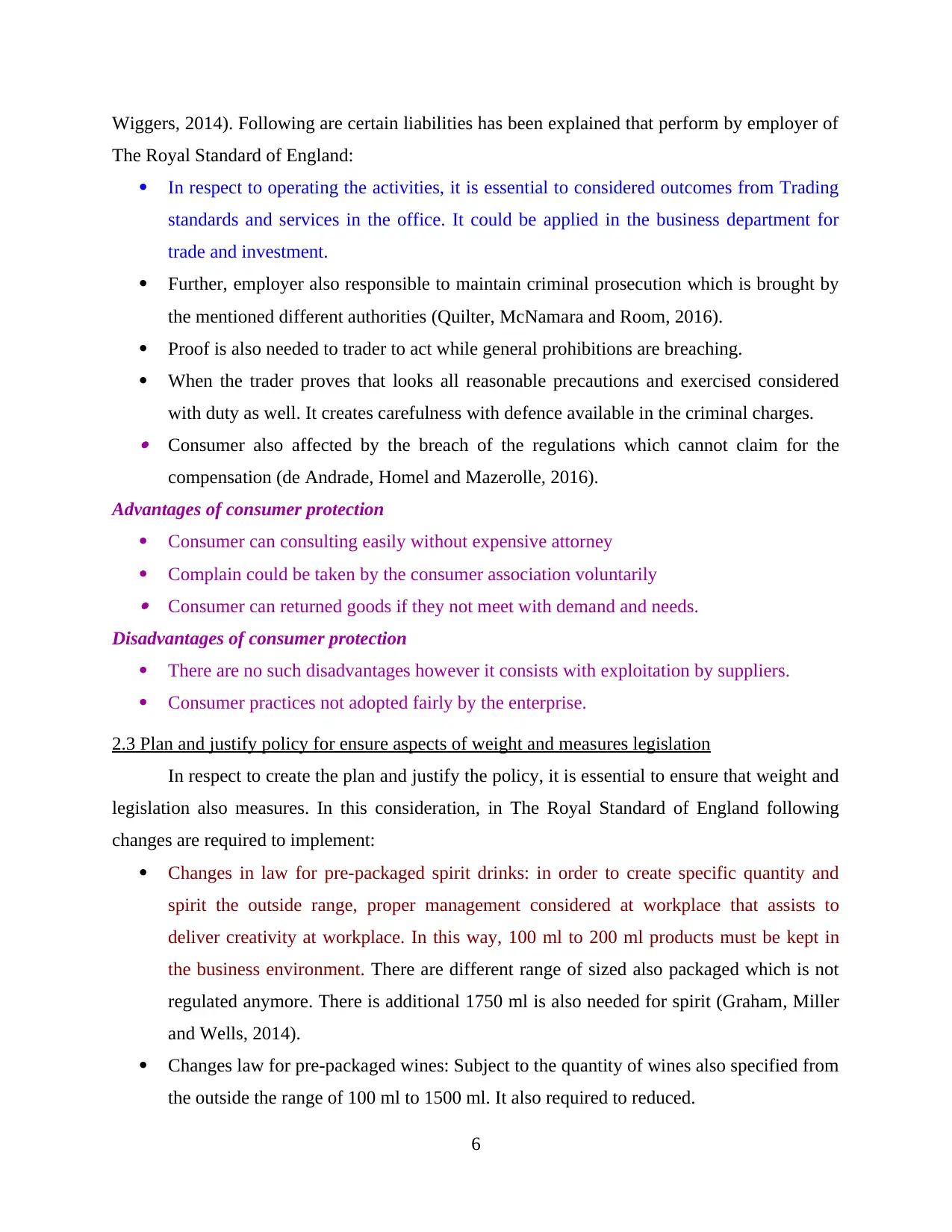
Wiggers, 2014). Following are certain liabilities has been explained that perform by employer of
The Royal Standard of England:
In respect to operating the activities, it is essential to considered outcomes from Trading
standards and services in the office. It could be applied in the business department for
trade and investment.
Further, employer also responsible to maintain criminal prosecution which is brought by
the mentioned different authorities (Quilter, McNamara and Room, 2016).
Proof is also needed to trader to act while general prohibitions are breaching.
When the trader proves that looks all reasonable precautions and exercised considered
with duty as well. It creates carefulness with defence available in the criminal charges. Consumer also affected by the breach of the regulations which cannot claim for the
compensation (de Andrade, Homel and Mazerolle, 2016).
Advantages of consumer protection
Consumer can consulting easily without expensive attorney
Complain could be taken by the consumer association voluntarily Consumer can returned goods if they not meet with demand and needs.
Disadvantages of consumer protection
There are no such disadvantages however it consists with exploitation by suppliers.
Consumer practices not adopted fairly by the enterprise.
2.3 Plan and justify policy for ensure aspects of weight and measures legislation
In respect to create the plan and justify the policy, it is essential to ensure that weight and
legislation also measures. In this consideration, in The Royal Standard of England following
changes are required to implement:
Changes in law for pre-packaged spirit drinks: in order to create specific quantity and
spirit the outside range, proper management considered at workplace that assists to
deliver creativity at workplace. In this way, 100 ml to 200 ml products must be kept in
the business environment. There are different range of sized also packaged which is not
regulated anymore. There is additional 1750 ml is also needed for spirit (Graham, Miller
and Wells, 2014).
Changes law for pre-packaged wines: Subject to the quantity of wines also specified from
the outside the range of 100 ml to 1500 ml. It also required to reduced.
6
The Royal Standard of England:
In respect to operating the activities, it is essential to considered outcomes from Trading
standards and services in the office. It could be applied in the business department for
trade and investment.
Further, employer also responsible to maintain criminal prosecution which is brought by
the mentioned different authorities (Quilter, McNamara and Room, 2016).
Proof is also needed to trader to act while general prohibitions are breaching.
When the trader proves that looks all reasonable precautions and exercised considered
with duty as well. It creates carefulness with defence available in the criminal charges. Consumer also affected by the breach of the regulations which cannot claim for the
compensation (de Andrade, Homel and Mazerolle, 2016).
Advantages of consumer protection
Consumer can consulting easily without expensive attorney
Complain could be taken by the consumer association voluntarily Consumer can returned goods if they not meet with demand and needs.
Disadvantages of consumer protection
There are no such disadvantages however it consists with exploitation by suppliers.
Consumer practices not adopted fairly by the enterprise.
2.3 Plan and justify policy for ensure aspects of weight and measures legislation
In respect to create the plan and justify the policy, it is essential to ensure that weight and
legislation also measures. In this consideration, in The Royal Standard of England following
changes are required to implement:
Changes in law for pre-packaged spirit drinks: in order to create specific quantity and
spirit the outside range, proper management considered at workplace that assists to
deliver creativity at workplace. In this way, 100 ml to 200 ml products must be kept in
the business environment. There are different range of sized also packaged which is not
regulated anymore. There is additional 1750 ml is also needed for spirit (Graham, Miller
and Wells, 2014).
Changes law for pre-packaged wines: Subject to the quantity of wines also specified from
the outside the range of 100 ml to 1500 ml. It also required to reduced.
6
You're viewing a preview
Unlock full access by subscribing today!
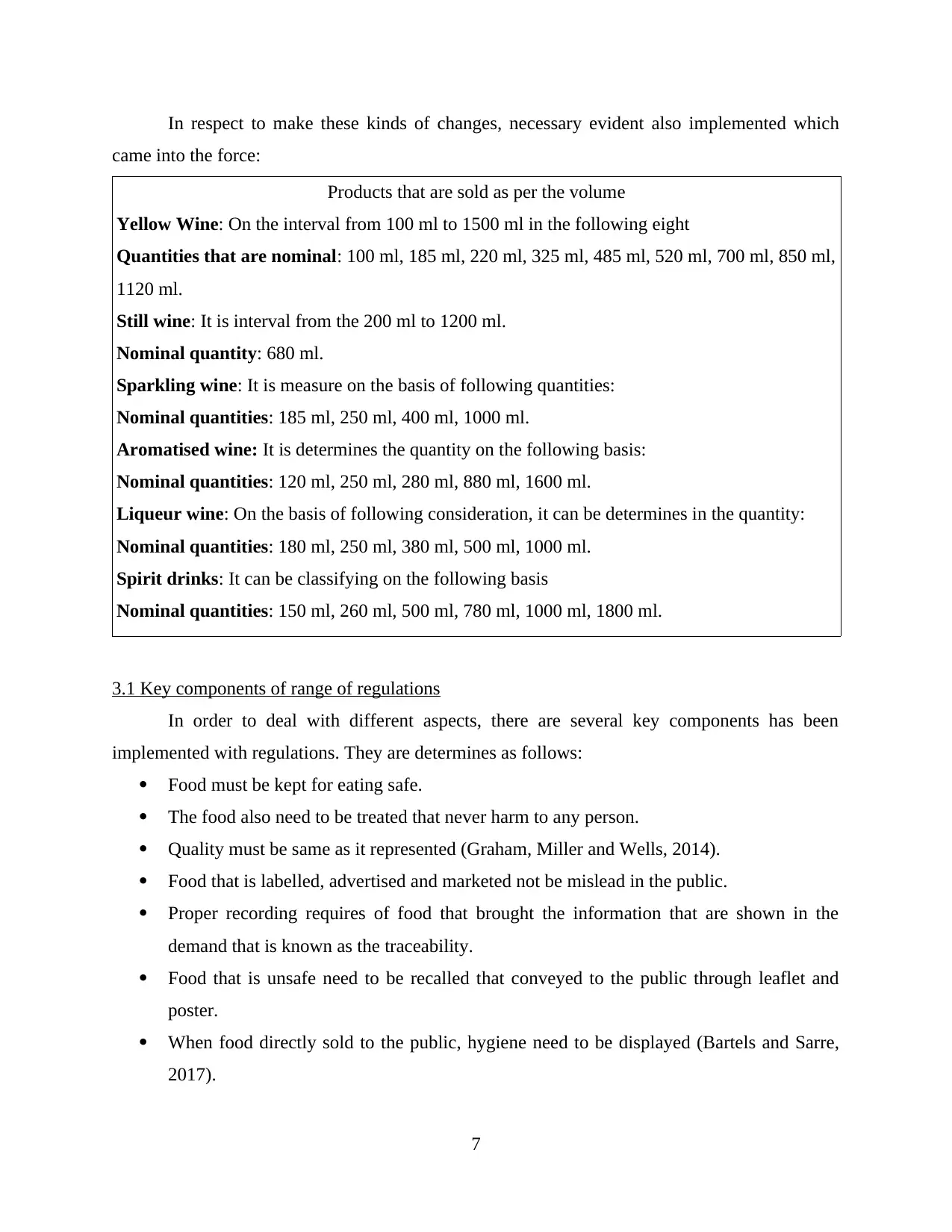
In respect to make these kinds of changes, necessary evident also implemented which
came into the force:
Products that are sold as per the volume
Yellow Wine: On the interval from 100 ml to 1500 ml in the following eight
Quantities that are nominal: 100 ml, 185 ml, 220 ml, 325 ml, 485 ml, 520 ml, 700 ml, 850 ml,
1120 ml.
Still wine: It is interval from the 200 ml to 1200 ml.
Nominal quantity: 680 ml.
Sparkling wine: It is measure on the basis of following quantities:
Nominal quantities: 185 ml, 250 ml, 400 ml, 1000 ml.
Aromatised wine: It is determines the quantity on the following basis:
Nominal quantities: 120 ml, 250 ml, 280 ml, 880 ml, 1600 ml.
Liqueur wine: On the basis of following consideration, it can be determines in the quantity:
Nominal quantities: 180 ml, 250 ml, 380 ml, 500 ml, 1000 ml.
Spirit drinks: It can be classifying on the following basis
Nominal quantities: 150 ml, 260 ml, 500 ml, 780 ml, 1000 ml, 1800 ml.
3.1 Key components of range of regulations
In order to deal with different aspects, there are several key components has been
implemented with regulations. They are determines as follows:
Food must be kept for eating safe.
The food also need to be treated that never harm to any person.
Quality must be same as it represented (Graham, Miller and Wells, 2014).
Food that is labelled, advertised and marketed not be mislead in the public.
Proper recording requires of food that brought the information that are shown in the
demand that is known as the traceability.
Food that is unsafe need to be recalled that conveyed to the public through leaflet and
poster.
When food directly sold to the public, hygiene need to be displayed (Bartels and Sarre,
2017).
7
came into the force:
Products that are sold as per the volume
Yellow Wine: On the interval from 100 ml to 1500 ml in the following eight
Quantities that are nominal: 100 ml, 185 ml, 220 ml, 325 ml, 485 ml, 520 ml, 700 ml, 850 ml,
1120 ml.
Still wine: It is interval from the 200 ml to 1200 ml.
Nominal quantity: 680 ml.
Sparkling wine: It is measure on the basis of following quantities:
Nominal quantities: 185 ml, 250 ml, 400 ml, 1000 ml.
Aromatised wine: It is determines the quantity on the following basis:
Nominal quantities: 120 ml, 250 ml, 280 ml, 880 ml, 1600 ml.
Liqueur wine: On the basis of following consideration, it can be determines in the quantity:
Nominal quantities: 180 ml, 250 ml, 380 ml, 500 ml, 1000 ml.
Spirit drinks: It can be classifying on the following basis
Nominal quantities: 150 ml, 260 ml, 500 ml, 780 ml, 1000 ml, 1800 ml.
3.1 Key components of range of regulations
In order to deal with different aspects, there are several key components has been
implemented with regulations. They are determines as follows:
Food must be kept for eating safe.
The food also need to be treated that never harm to any person.
Quality must be same as it represented (Graham, Miller and Wells, 2014).
Food that is labelled, advertised and marketed not be mislead in the public.
Proper recording requires of food that brought the information that are shown in the
demand that is known as the traceability.
Food that is unsafe need to be recalled that conveyed to the public through leaflet and
poster.
When food directly sold to the public, hygiene need to be displayed (Bartels and Sarre,
2017).
7
Paraphrase This Document
Need a fresh take? Get an instant paraphrase of this document with our AI Paraphraser
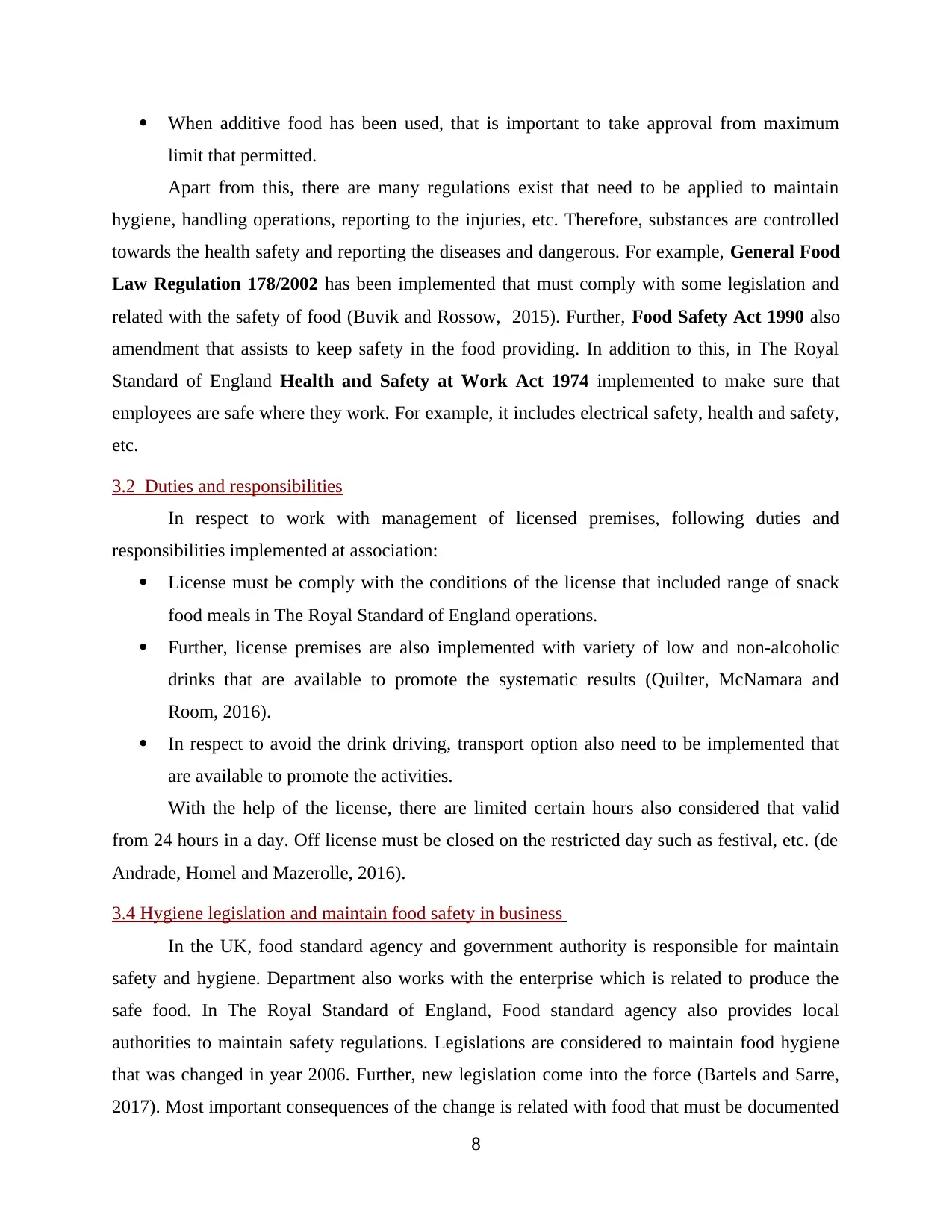
When additive food has been used, that is important to take approval from maximum
limit that permitted.
Apart from this, there are many regulations exist that need to be applied to maintain
hygiene, handling operations, reporting to the injuries, etc. Therefore, substances are controlled
towards the health safety and reporting the diseases and dangerous. For example, General Food
Law Regulation 178/2002 has been implemented that must comply with some legislation and
related with the safety of food (Buvik and Rossow, 2015). Further, Food Safety Act 1990 also
amendment that assists to keep safety in the food providing. In addition to this, in The Royal
Standard of England Health and Safety at Work Act 1974 implemented to make sure that
employees are safe where they work. For example, it includes electrical safety, health and safety,
etc.
3.2 Duties and responsibilities
In respect to work with management of licensed premises, following duties and
responsibilities implemented at association:
License must be comply with the conditions of the license that included range of snack
food meals in The Royal Standard of England operations.
Further, license premises are also implemented with variety of low and non-alcoholic
drinks that are available to promote the systematic results (Quilter, McNamara and
Room, 2016).
In respect to avoid the drink driving, transport option also need to be implemented that
are available to promote the activities.
With the help of the license, there are limited certain hours also considered that valid
from 24 hours in a day. Off license must be closed on the restricted day such as festival, etc. (de
Andrade, Homel and Mazerolle, 2016).
3.4 Hygiene legislation and maintain food safety in business
In the UK, food standard agency and government authority is responsible for maintain
safety and hygiene. Department also works with the enterprise which is related to produce the
safe food. In The Royal Standard of England, Food standard agency also provides local
authorities to maintain safety regulations. Legislations are considered to maintain food hygiene
that was changed in year 2006. Further, new legislation come into the force (Bartels and Sarre,
2017). Most important consequences of the change is related with food that must be documented
8
limit that permitted.
Apart from this, there are many regulations exist that need to be applied to maintain
hygiene, handling operations, reporting to the injuries, etc. Therefore, substances are controlled
towards the health safety and reporting the diseases and dangerous. For example, General Food
Law Regulation 178/2002 has been implemented that must comply with some legislation and
related with the safety of food (Buvik and Rossow, 2015). Further, Food Safety Act 1990 also
amendment that assists to keep safety in the food providing. In addition to this, in The Royal
Standard of England Health and Safety at Work Act 1974 implemented to make sure that
employees are safe where they work. For example, it includes electrical safety, health and safety,
etc.
3.2 Duties and responsibilities
In respect to work with management of licensed premises, following duties and
responsibilities implemented at association:
License must be comply with the conditions of the license that included range of snack
food meals in The Royal Standard of England operations.
Further, license premises are also implemented with variety of low and non-alcoholic
drinks that are available to promote the systematic results (Quilter, McNamara and
Room, 2016).
In respect to avoid the drink driving, transport option also need to be implemented that
are available to promote the activities.
With the help of the license, there are limited certain hours also considered that valid
from 24 hours in a day. Off license must be closed on the restricted day such as festival, etc. (de
Andrade, Homel and Mazerolle, 2016).
3.4 Hygiene legislation and maintain food safety in business
In the UK, food standard agency and government authority is responsible for maintain
safety and hygiene. Department also works with the enterprise which is related to produce the
safe food. In The Royal Standard of England, Food standard agency also provides local
authorities to maintain safety regulations. Legislations are considered to maintain food hygiene
that was changed in year 2006. Further, new legislation come into the force (Bartels and Sarre,
2017). Most important consequences of the change is related with food that must be documented
8
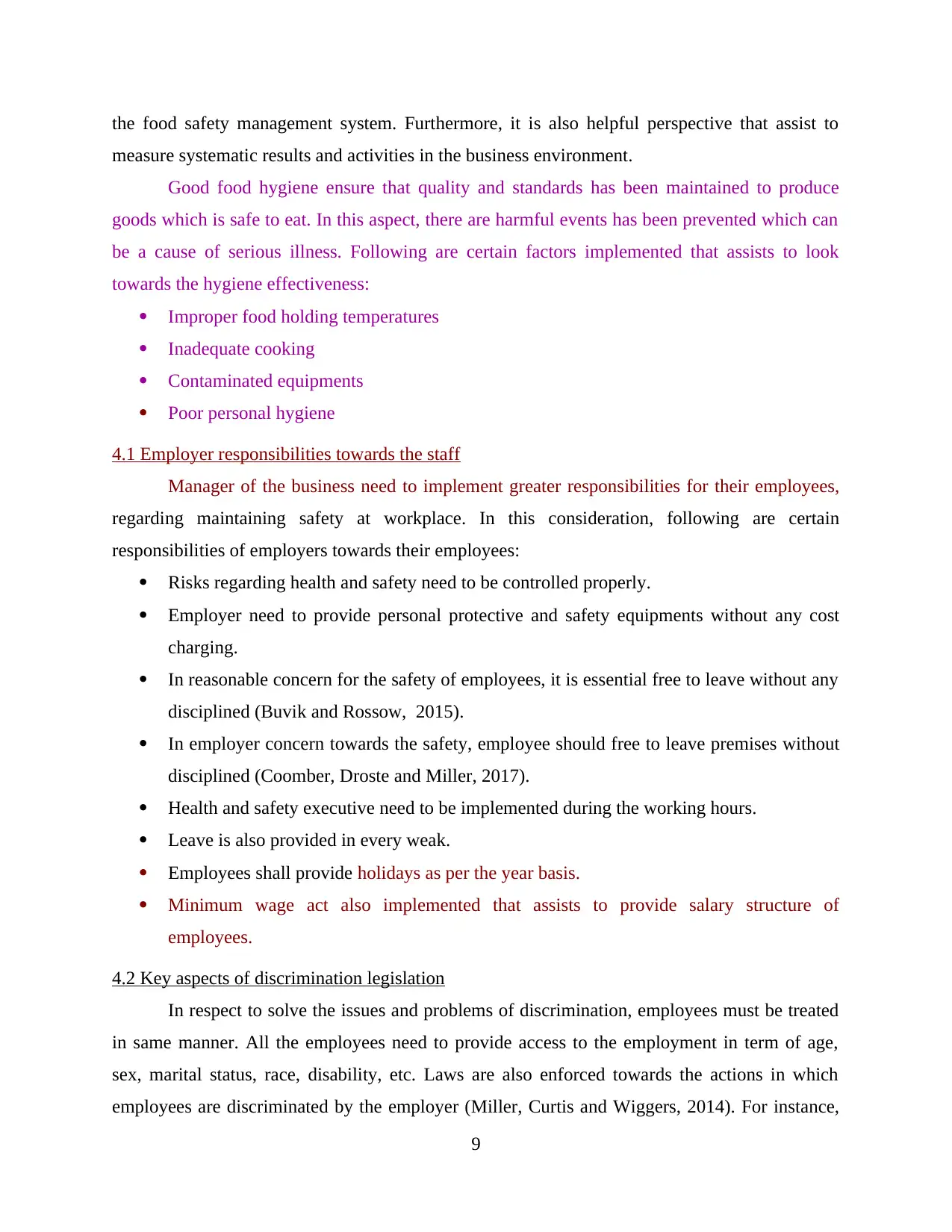
the food safety management system. Furthermore, it is also helpful perspective that assist to
measure systematic results and activities in the business environment.
Good food hygiene ensure that quality and standards has been maintained to produce
goods which is safe to eat. In this aspect, there are harmful events has been prevented which can
be a cause of serious illness. Following are certain factors implemented that assists to look
towards the hygiene effectiveness:
Improper food holding temperatures
Inadequate cooking
Contaminated equipments
Poor personal hygiene
4.1 Employer responsibilities towards the staff
Manager of the business need to implement greater responsibilities for their employees,
regarding maintaining safety at workplace. In this consideration, following are certain
responsibilities of employers towards their employees:
Risks regarding health and safety need to be controlled properly.
Employer need to provide personal protective and safety equipments without any cost
charging.
In reasonable concern for the safety of employees, it is essential free to leave without any
disciplined (Buvik and Rossow, 2015).
In employer concern towards the safety, employee should free to leave premises without
disciplined (Coomber, Droste and Miller, 2017).
Health and safety executive need to be implemented during the working hours.
Leave is also provided in every weak.
Employees shall provide holidays as per the year basis.
Minimum wage act also implemented that assists to provide salary structure of
employees.
4.2 Key aspects of discrimination legislation
In respect to solve the issues and problems of discrimination, employees must be treated
in same manner. All the employees need to provide access to the employment in term of age,
sex, marital status, race, disability, etc. Laws are also enforced towards the actions in which
employees are discriminated by the employer (Miller, Curtis and Wiggers, 2014). For instance,
9
measure systematic results and activities in the business environment.
Good food hygiene ensure that quality and standards has been maintained to produce
goods which is safe to eat. In this aspect, there are harmful events has been prevented which can
be a cause of serious illness. Following are certain factors implemented that assists to look
towards the hygiene effectiveness:
Improper food holding temperatures
Inadequate cooking
Contaminated equipments
Poor personal hygiene
4.1 Employer responsibilities towards the staff
Manager of the business need to implement greater responsibilities for their employees,
regarding maintaining safety at workplace. In this consideration, following are certain
responsibilities of employers towards their employees:
Risks regarding health and safety need to be controlled properly.
Employer need to provide personal protective and safety equipments without any cost
charging.
In reasonable concern for the safety of employees, it is essential free to leave without any
disciplined (Buvik and Rossow, 2015).
In employer concern towards the safety, employee should free to leave premises without
disciplined (Coomber, Droste and Miller, 2017).
Health and safety executive need to be implemented during the working hours.
Leave is also provided in every weak.
Employees shall provide holidays as per the year basis.
Minimum wage act also implemented that assists to provide salary structure of
employees.
4.2 Key aspects of discrimination legislation
In respect to solve the issues and problems of discrimination, employees must be treated
in same manner. All the employees need to provide access to the employment in term of age,
sex, marital status, race, disability, etc. Laws are also enforced towards the actions in which
employees are discriminated by the employer (Miller, Curtis and Wiggers, 2014). For instance,
9
You're viewing a preview
Unlock full access by subscribing today!
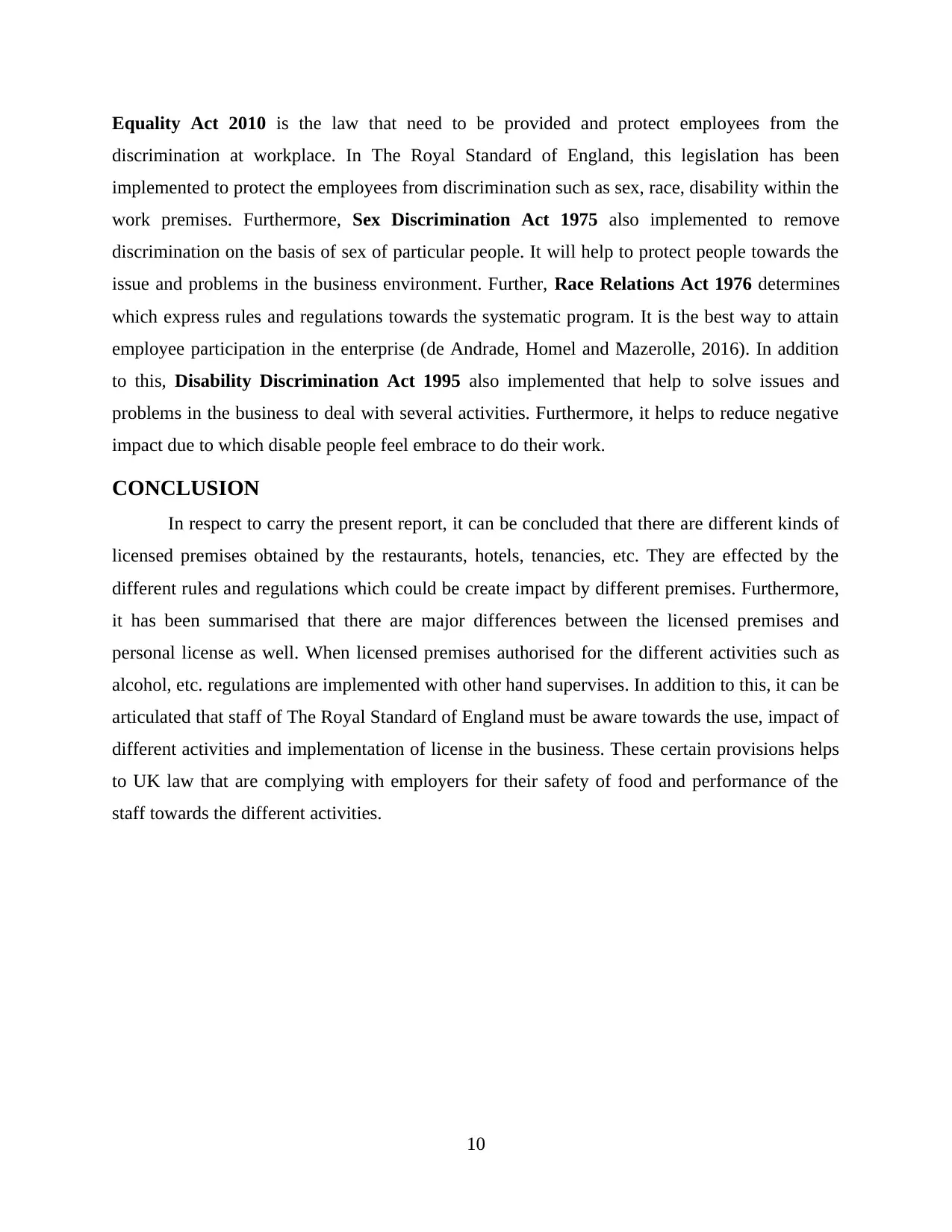
Equality Act 2010 is the law that need to be provided and protect employees from the
discrimination at workplace. In The Royal Standard of England, this legislation has been
implemented to protect the employees from discrimination such as sex, race, disability within the
work premises. Furthermore, Sex Discrimination Act 1975 also implemented to remove
discrimination on the basis of sex of particular people. It will help to protect people towards the
issue and problems in the business environment. Further, Race Relations Act 1976 determines
which express rules and regulations towards the systematic program. It is the best way to attain
employee participation in the enterprise (de Andrade, Homel and Mazerolle, 2016). In addition
to this, Disability Discrimination Act 1995 also implemented that help to solve issues and
problems in the business to deal with several activities. Furthermore, it helps to reduce negative
impact due to which disable people feel embrace to do their work.
CONCLUSION
In respect to carry the present report, it can be concluded that there are different kinds of
licensed premises obtained by the restaurants, hotels, tenancies, etc. They are effected by the
different rules and regulations which could be create impact by different premises. Furthermore,
it has been summarised that there are major differences between the licensed premises and
personal license as well. When licensed premises authorised for the different activities such as
alcohol, etc. regulations are implemented with other hand supervises. In addition to this, it can be
articulated that staff of The Royal Standard of England must be aware towards the use, impact of
different activities and implementation of license in the business. These certain provisions helps
to UK law that are complying with employers for their safety of food and performance of the
staff towards the different activities.
10
discrimination at workplace. In The Royal Standard of England, this legislation has been
implemented to protect the employees from discrimination such as sex, race, disability within the
work premises. Furthermore, Sex Discrimination Act 1975 also implemented to remove
discrimination on the basis of sex of particular people. It will help to protect people towards the
issue and problems in the business environment. Further, Race Relations Act 1976 determines
which express rules and regulations towards the systematic program. It is the best way to attain
employee participation in the enterprise (de Andrade, Homel and Mazerolle, 2016). In addition
to this, Disability Discrimination Act 1995 also implemented that help to solve issues and
problems in the business to deal with several activities. Furthermore, it helps to reduce negative
impact due to which disable people feel embrace to do their work.
CONCLUSION
In respect to carry the present report, it can be concluded that there are different kinds of
licensed premises obtained by the restaurants, hotels, tenancies, etc. They are effected by the
different rules and regulations which could be create impact by different premises. Furthermore,
it has been summarised that there are major differences between the licensed premises and
personal license as well. When licensed premises authorised for the different activities such as
alcohol, etc. regulations are implemented with other hand supervises. In addition to this, it can be
articulated that staff of The Royal Standard of England must be aware towards the use, impact of
different activities and implementation of license in the business. These certain provisions helps
to UK law that are complying with employers for their safety of food and performance of the
staff towards the different activities.
10
Paraphrase This Document
Need a fresh take? Get an instant paraphrase of this document with our AI Paraphraser
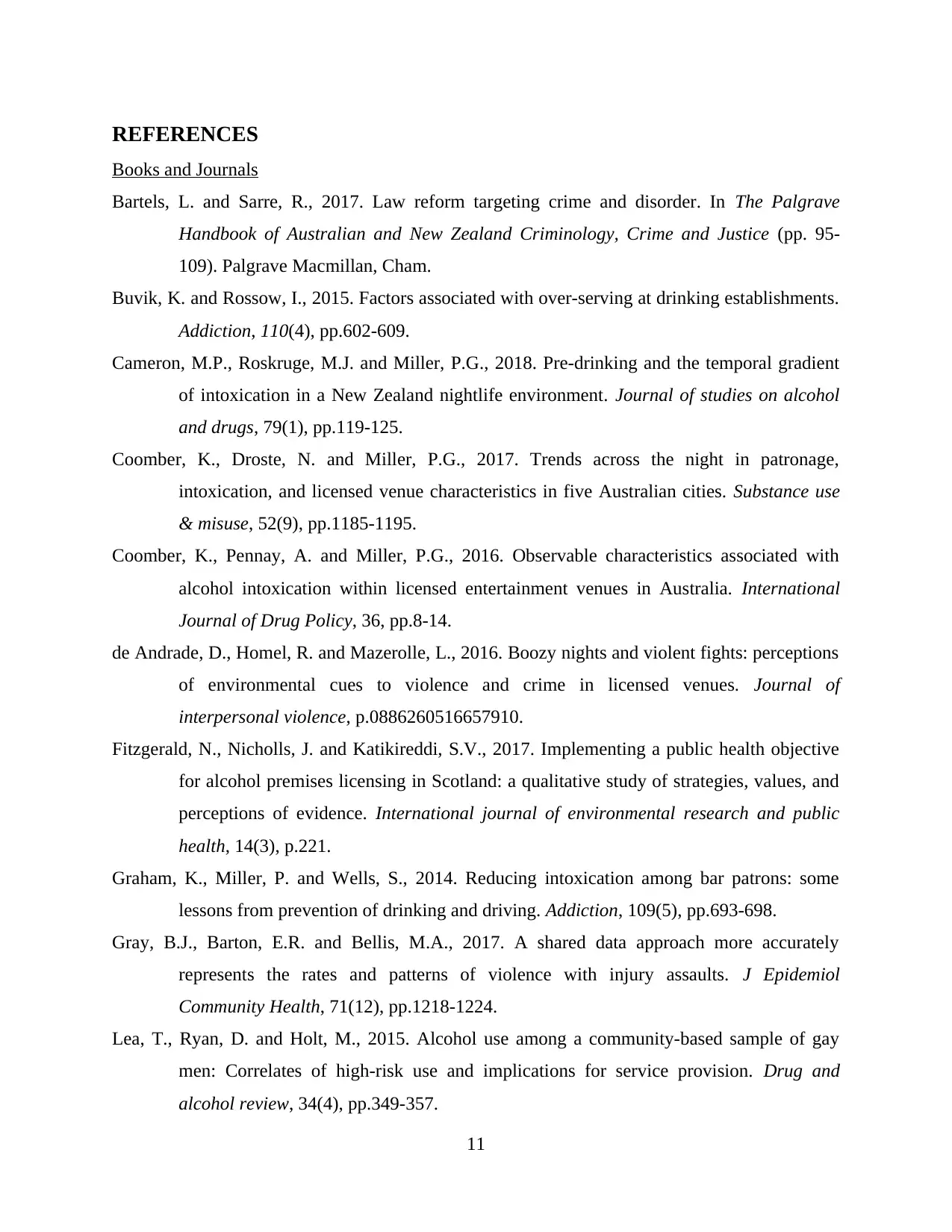
REFERENCES
Books and Journals
Bartels, L. and Sarre, R., 2017. Law reform targeting crime and disorder. In The Palgrave
Handbook of Australian and New Zealand Criminology, Crime and Justice (pp. 95-
109). Palgrave Macmillan, Cham.
Buvik, K. and Rossow, I., 2015. Factors associated with over‐serving at drinking establishments.
Addiction, 110(4), pp.602-609.
Cameron, M.P., Roskruge, M.J. and Miller, P.G., 2018. Pre-drinking and the temporal gradient
of intoxication in a New Zealand nightlife environment. Journal of studies on alcohol
and drugs, 79(1), pp.119-125.
Coomber, K., Droste, N. and Miller, P.G., 2017. Trends across the night in patronage,
intoxication, and licensed venue characteristics in five Australian cities. Substance use
& misuse, 52(9), pp.1185-1195.
Coomber, K., Pennay, A. and Miller, P.G., 2016. Observable characteristics associated with
alcohol intoxication within licensed entertainment venues in Australia. International
Journal of Drug Policy, 36, pp.8-14.
de Andrade, D., Homel, R. and Mazerolle, L., 2016. Boozy nights and violent fights: perceptions
of environmental cues to violence and crime in licensed venues. Journal of
interpersonal violence, p.0886260516657910.
Fitzgerald, N., Nicholls, J. and Katikireddi, S.V., 2017. Implementing a public health objective
for alcohol premises licensing in Scotland: a qualitative study of strategies, values, and
perceptions of evidence. International journal of environmental research and public
health, 14(3), p.221.
Graham, K., Miller, P. and Wells, S., 2014. Reducing intoxication among bar patrons: some
lessons from prevention of drinking and driving. Addiction, 109(5), pp.693-698.
Gray, B.J., Barton, E.R. and Bellis, M.A., 2017. A shared data approach more accurately
represents the rates and patterns of violence with injury assaults. J Epidemiol
Community Health, 71(12), pp.1218-1224.
Lea, T., Ryan, D. and Holt, M., 2015. Alcohol use among a community‐based sample of gay
men: Correlates of high‐risk use and implications for service provision. Drug and
alcohol review, 34(4), pp.349-357.
11
Books and Journals
Bartels, L. and Sarre, R., 2017. Law reform targeting crime and disorder. In The Palgrave
Handbook of Australian and New Zealand Criminology, Crime and Justice (pp. 95-
109). Palgrave Macmillan, Cham.
Buvik, K. and Rossow, I., 2015. Factors associated with over‐serving at drinking establishments.
Addiction, 110(4), pp.602-609.
Cameron, M.P., Roskruge, M.J. and Miller, P.G., 2018. Pre-drinking and the temporal gradient
of intoxication in a New Zealand nightlife environment. Journal of studies on alcohol
and drugs, 79(1), pp.119-125.
Coomber, K., Droste, N. and Miller, P.G., 2017. Trends across the night in patronage,
intoxication, and licensed venue characteristics in five Australian cities. Substance use
& misuse, 52(9), pp.1185-1195.
Coomber, K., Pennay, A. and Miller, P.G., 2016. Observable characteristics associated with
alcohol intoxication within licensed entertainment venues in Australia. International
Journal of Drug Policy, 36, pp.8-14.
de Andrade, D., Homel, R. and Mazerolle, L., 2016. Boozy nights and violent fights: perceptions
of environmental cues to violence and crime in licensed venues. Journal of
interpersonal violence, p.0886260516657910.
Fitzgerald, N., Nicholls, J. and Katikireddi, S.V., 2017. Implementing a public health objective
for alcohol premises licensing in Scotland: a qualitative study of strategies, values, and
perceptions of evidence. International journal of environmental research and public
health, 14(3), p.221.
Graham, K., Miller, P. and Wells, S., 2014. Reducing intoxication among bar patrons: some
lessons from prevention of drinking and driving. Addiction, 109(5), pp.693-698.
Gray, B.J., Barton, E.R. and Bellis, M.A., 2017. A shared data approach more accurately
represents the rates and patterns of violence with injury assaults. J Epidemiol
Community Health, 71(12), pp.1218-1224.
Lea, T., Ryan, D. and Holt, M., 2015. Alcohol use among a community‐based sample of gay
men: Correlates of high‐risk use and implications for service provision. Drug and
alcohol review, 34(4), pp.349-357.
11
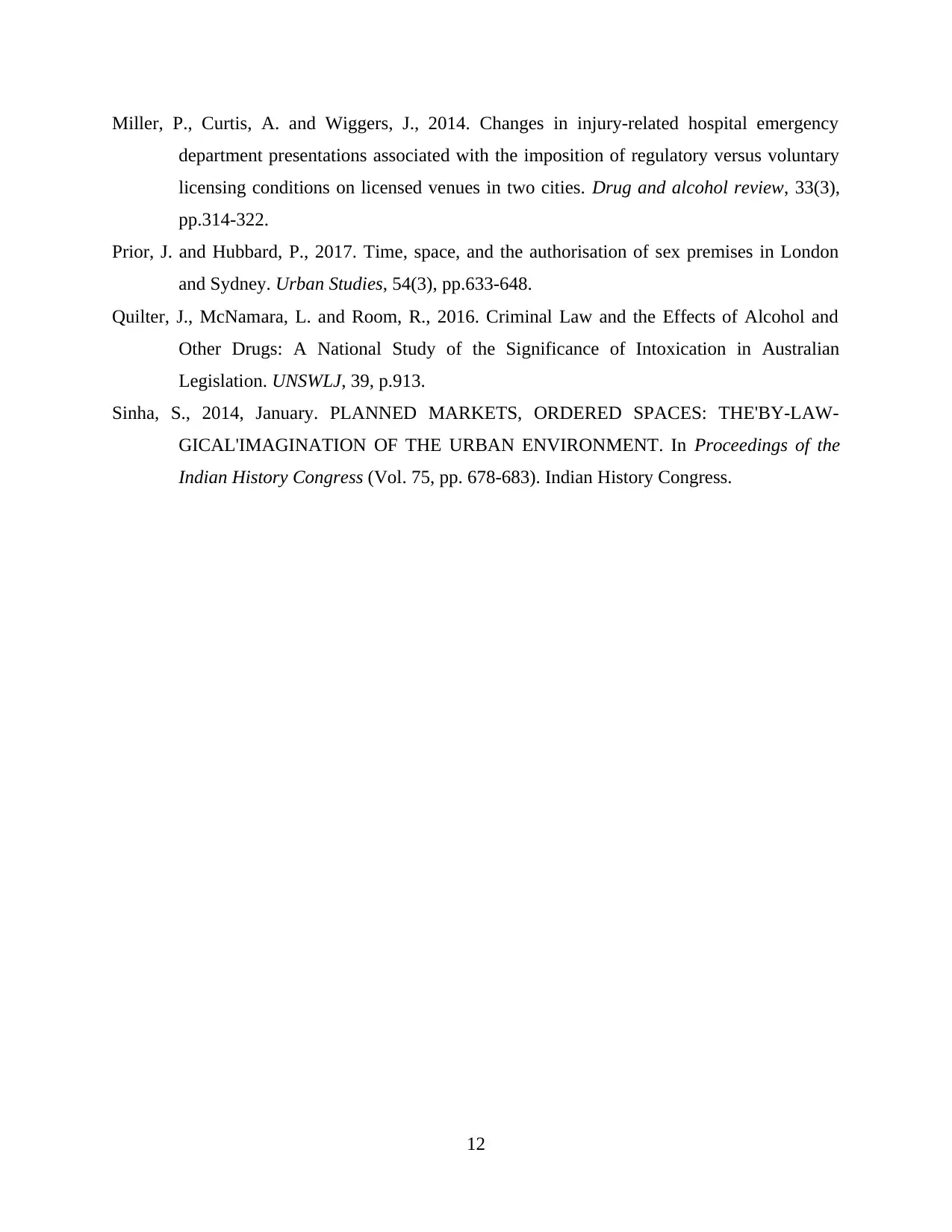
Miller, P., Curtis, A. and Wiggers, J., 2014. Changes in injury‐related hospital emergency
department presentations associated with the imposition of regulatory versus voluntary
licensing conditions on licensed venues in two cities. Drug and alcohol review, 33(3),
pp.314-322.
Prior, J. and Hubbard, P., 2017. Time, space, and the authorisation of sex premises in London
and Sydney. Urban Studies, 54(3), pp.633-648.
Quilter, J., McNamara, L. and Room, R., 2016. Criminal Law and the Effects of Alcohol and
Other Drugs: A National Study of the Significance of Intoxication in Australian
Legislation. UNSWLJ, 39, p.913.
Sinha, S., 2014, January. PLANNED MARKETS, ORDERED SPACES: THE'BY-LAW-
GICAL'IMAGINATION OF THE URBAN ENVIRONMENT. In Proceedings of the
Indian History Congress (Vol. 75, pp. 678-683). Indian History Congress.
12
department presentations associated with the imposition of regulatory versus voluntary
licensing conditions on licensed venues in two cities. Drug and alcohol review, 33(3),
pp.314-322.
Prior, J. and Hubbard, P., 2017. Time, space, and the authorisation of sex premises in London
and Sydney. Urban Studies, 54(3), pp.633-648.
Quilter, J., McNamara, L. and Room, R., 2016. Criminal Law and the Effects of Alcohol and
Other Drugs: A National Study of the Significance of Intoxication in Australian
Legislation. UNSWLJ, 39, p.913.
Sinha, S., 2014, January. PLANNED MARKETS, ORDERED SPACES: THE'BY-LAW-
GICAL'IMAGINATION OF THE URBAN ENVIRONMENT. In Proceedings of the
Indian History Congress (Vol. 75, pp. 678-683). Indian History Congress.
12
You're viewing a preview
Unlock full access by subscribing today!
1 out of 15
Related Documents
Your All-in-One AI-Powered Toolkit for Academic Success.
+13062052269
info@desklib.com
Available 24*7 on WhatsApp / Email
![[object Object]](/_next/static/media/star-bottom.7253800d.svg)
Unlock your academic potential
© 2024 | Zucol Services PVT LTD | All rights reserved.





